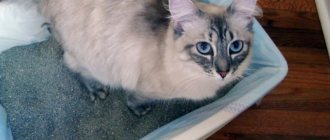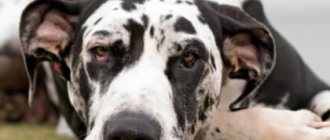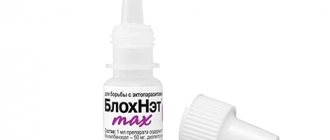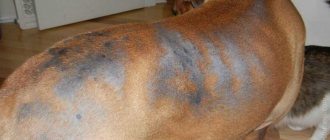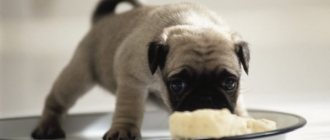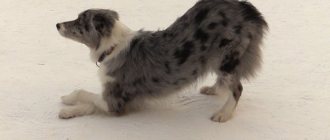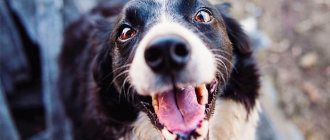Normal and abnormalities in dog excrement
If a dog has yellow feces, then everything is definitely not in order with his health.
Any life process has a normal framework within which it must be included. If the animal begins to eat more or less, this indicates a violation. It's the same story with feces. Yellow feces in a dog are not normal, but indicate the presence of some acute or chronic diseases, but this is not always the case.
Typically, dog feces are the same diameter as the anal ring. Their smell is unpleasant, but in comparison with the deviations it is quite moderate. Animals usually walk up to three times a day. If the dog pooped 1-2 times, then this is also normal. There should be no cracks or inclusions in the stool. It is important to take care of the coat, as it should normally be clean and not dirty.
Important! The feces should be slightly shiny, and its shape should be maintained for a minute after the act of defecation. If pieces fall out, this indicates a lack of fiber. If everything is normal and there is enough fiber, then the feces will shine in the light.
Signs of health problems are expressed in such characteristics as:
- Decoration of feces. After the usual “sausage”, a cloudy slurry comes out.
- The presence of mucus, when the appearance is normal, but the “sausage” is covered with slippery secretions.
- Violation of stool consistency. If a dog has yellow or black diarrhea, this indicates problems with the gastrointestinal tract.
- Dry stool. If the “sausage” shape is observed, but it is dry, and bowel movements occur once a day or less often.
What does the color of a dog's stool indicate?
A change in the color of stool indicates that something is wrong with the body and she needs help. For example, yellow diarrhea in a dog can be the result not only of changes in the body and the occurrence of diseases, but also of overeating foods containing carotene in large quantities.
If we talk about yellow stools, the following diseases may be the culprits:
- Liver cirrhosis, hepatitis or neoplasia. This is a transition period during which the color of stool instead of normal brown becomes light and then completely white.
- Parasites. Often, such a problem appears due to the activity of helminths and other parasites in the animal’s body, for which it is also necessary to be treated.
- Pancreas and lack of certain hormones. Because of this, fats are not processed properly, and the stool takes on an oily texture and a yellowish tint.
With cirrhosis, the dog feels lethargic and does not play
Diagnosis of the causes of diarrhea
If diarrhea is accompanied by vomiting, a depressed state of the animal, lack of appetite, changes in body temperature, pain and does not decrease within twelve hours, you must urgently take your pet to a veterinary clinic.
Examination of the animal to determine the causes of diarrhea includes:
- general examination, identification of existing symptoms: stool color, consistency, smell, presence of vomiting, etc.;
- various blood tests to determine the degree of inflammatory processes, the presence of infections, disorders of the liver, genitourinary system, pancreas;
- a urine test to determine the presence of inflammation in the kidneys;
- stool analysis by flotation method, which determines the presence of parasitic infection;
- X-ray and ultrasound of the abdominal cavity;
- PCR analysis for viral and bacterial infections;
- bacterial culture - analysis necessary to determine the level of sensitivity to antibiotics;
- serological testing for infectious diseases;
- endoscopy and colonoscopy are methods that help assess the condition of the large and small intestines;
- special tests for toxins.
Possible causes of yellow feces in dogs
If the owner observes yellow poop in the dog, then most likely this is a problem of malnutrition. If you give your dog very fatty food, he will not be able to digest it, and his gastrointestinal tract will begin to malfunction. This will certainly lead to a change in the color, shade or consistency of the stool. You should not give your dog cottage cheese, butter and other fatty things. If the situation has not changed after correcting your diet, you should immediately consult a doctor.
Important! Due to improper and unhealthy nutrition, feces change their color to lighter or darker, not only due to gastrointestinal disorders, but also due to liver and pancreatic diseases, which begin to actively develop against this background.
If the stool has a mushy structure, with large and small grains of undigested food, this indicates a serious violation of the food intake and its poor quality.
Orange diarrhea: why it happens
Orange feces in a dog, which has a sharp and “sour” odor, indicate that the animal has become infected with jaundice. This is observed not only in large dogs, but also in puppies up to a year old. The shade changes due to the huge concentration of bilirubin in the animal’s blood, which is actively secreted into the intestinal lumens and enters the digested food.
In addition to this symptom, jaundice may cause:
- vomiting and retching;
- nausea;
- discoloration of the mucous membranes in a yellowish color.
With mucus
If your dog has diarrhea, vomiting and mucus and/or blood, it is necessary to immediately contact a veterinarian, where he will be properly examined and promptly treated. If mechanical damage, tumor processes and other complications are diagnosed, the doctor will prescribe surgery. To clarify the picture and general condition, the doctor will take a stool sample and conduct an X-ray of the abdominal cavity. If we talk about the probable causes of this condition, we can highlight the following points:
- severe damage to the intestinal walls;
- formation of pancreatitis or gastric ulcer;
- state of dysbacteriosis;
- the presence of parasites in the area of internal organs;
- manifestation of atypical forms of rabies;
- poisoning by poisons or medications;
- the presence of tumors and infectious processes in the intestine.
Typically, diarrhea, which forms along with mucus, is accompanied by a whole range of symptoms. They are that:
- the dog loses the ability to lead active life activities and leads a predominantly recumbent lifestyle;
- the dog refuses to eat and goes for a walk without much enthusiasm;
- the pet looks tired and tired, even if it has barely moved during the day;
- the pet often whines, or rather, whines, most often this happens due to abdominal pain;
- Nausea and vomiting appear (not always).
The appearance of mucus in the stool is a clear sign of pathology and cannot be a natural process. Therefore, if such a phenomenon is detected, the owners should show the dog to a veterinarian, who, after conducting a series of studies, will identify the cause of the condition and prescribe adequate treatment.
The dangers of bright yellow diarrhea
Very often, feces turn bright orange during the active development of pancreatic cancer, which occurs in the form of jaundice. Similar symptoms are also observed in less serious but severe diseases:
- liver cirrhosis;
- pancreatitis;
- piroplasmosis;
- blockage of the gallbladder.
If you notice yellow discharge, you should immediately contact your veterinarian
White stool
The white color of feces, first of all, indicates tumor formations in the liver, gall bladder or digestive organs. Such excrement may indicate the following disorders in the body:
- Malignant tumors of the liver or gallbladder disrupt the normal flow of bile.
- Inflammation of the pancreas (pancreatitis).
- Inflammation of the liver and bile ducts (cholangiohepatitis, cholangitis).
- Inflammatory process in the liver (infectious and toxic hepatitis).
- Liver failure with threat of liver cirrhosis.
- The formation of cystic nodes in the liver and disruption of the functions of this important organ.
- Changes in the gallbladder - its deformation, reduction in size.
- Excessive consumption of foods with high fat content (pork, sour cream) or other unusual foods. In the absence of other symptoms (vomiting, abdominal pain, apathy), it is allowed to monitor the dog’s stool for one day before going to the clinic, provided that the owner is sure that the origin of the white feces is due to an error in the diet.
Do I need to contact a veterinarian?
A change in the color of stool indicates disturbances in the functioning of the body and the gastrointestinal tract in particular. This is the first sign of the disease that the animal owner notices. As a rule, a hot nose or a change in the color of the mucous membranes goes unnoticed. If the dog has eaten a lot of foods with carotene, then the feces will change color precisely because of this.
Note! You should limit your diet and check your assumptions. With such “poisoning” the animal will run and jump as if nothing had happened.
If your pet has not consumed anything like this, it is recommended to immediately call a veterinarian or take the dog to the clinic yourself.
Treatment
Before a set of treatment procedures, it is necessary to determine the exact cause of the lesion. A set of appropriate diagnostic measures helps with this:
- Conducting a general examination of the animal for stool color, consistency, smell;
- taking blood fluid tests to determine the degree of inflammation;
- urine analysis to determine inflammatory processes in the kidney area;
- examination of stool to determine parasite infection;
- ultrasound examination and radiography in the abdominal cavity;
- carrying out PCR analysis for bacteria and viruses;
- culture to determine the sensitivity of the animal to antibiotic compounds;
- serological practice, which involves identifying infections;
- endoscopy;
- analytical activities for toxins.
After this, a reasonable question arises - what to do next. Of course, this symptom absolutely cannot be ignored, even if it manifests itself and then disappears after a certain period of time. After all, damaged intestinal walls can lead to more serious consequences and complications. If the disease is harmless and safe, the doctor prescribes tablets and solutions, and then conducts a follow-up examination after all signs have passed. If we are talking about a complex lesion, surgical intervention is prescribed.
The general scheme of the therapeutic process is quite simple and understandable: you just need to rinse the dog’s stomach, doing this in the clinic, and then give him adsorbents to drink. Sometimes global treatment with antibiotics may be required. Organizing proper nutrition for your pet during treatment and rehabilitation plays an important role. All means and methods are prescribed by the attending physician.
Drug therapy
The most dangerous consequence of this condition is dehydration and death, so owners must provide first aid measures in order to help their pet recover.
- REHYDRON solution is given from a syringe. It helps to effectively normalize the level of moisture in the body and prevents vomiting.
- Activated carbon promotes the rapid removal of toxins. The optimal dosage is taken at the rate of one tablet per 10 kg of body weight. This drug must be given every 5-6 hours, depending on the degree of damage.
- SMEKTA. The purpose of using this drug is also to remove toxins. It is sold in sachets of powder, which is diluted in water and taken twice a day or more often.
- No-shpa, Papaverine. If an animal suffers from pain (and this can be seen by its behavior and reaction to stroking its tummy), it is necessary to give it these painkillers.
A prerequisite for therapy is the exclusion of meals during the first day of the disease, as well as providing the dog with plenty of drink. The main treatment regimen can be prescribed only after a full study has been carried out and the exact causative agent of this disease, which has become the causative factor of yellow diarrhea, has been identified. Folk remedies can provide a supplement to this therapy.
Traditional methods of treatment
To treat diarrhea, you can offer your pet a rice-based decoction, as well as a medicinal decoction of chamomile, oak bark, cinquefoil root, herbs and St. John's wort flowers. If diarrhea has gone too far and continues for more than 3 days, the use of an infusion based on pomegranate peel is indicated. All these healing compounds have a powerful anti-inflammatory, astringent, and restorative effect. Reception: several times a day, 1 tbsp. l. The dose and regimen is always selected based on the age and size (breed) of the dog.
Prevention of the condition
To prevent this condition of the animal, you should:
- give up fatty foods;
- monitor the dog’s hygiene;
- regularly add vitamins and microelements to the feed;
- monitor your pet's health.
The right approach to diet will help avoid diarrhea and changes in stool color.
Knowing why a dog may have yellow stool and what diseases such a symptom is a harbinger of, the owner will be able to provide timely help to the pet. It is enough to fulfill a number of conditions: reduce the amount of fatty foods, undergo regular examinations and examinations by a veterinarian and maintain hygiene.
How is the diagnosis carried out?
Examining a sick animal and making an accurate diagnosis is the first step towards its successful treatment, which is why it is so important for owners to promptly seek qualified medical help.
The entire diagnostic process is based on the following steps:
- visual examination of the dog with palpation of the liver and stomach through the abdominal wall, as well as examination of feces (if samples are currently available);
- taking a clinical and biochemical blood test, the results of which will help determine the level of spread of the inflammatory process, as well as identify specific infectious agents that have caused disturbances in the hepatobiliary, endocrine and urinary systems;
- passing a general analysis of urine and feces;
- conducting X-ray and ultrasound examinations of the abdominal organs.
Taken together, the results obtained allow the veterinarian to form a general picture of what is happening, but if certain questions still remain, additional diagnostic methods will help answer them: polymer chain reaction to identify viruses and harmful bacteria, serological testing of a blood test (if there is a suspicion of infection), colonoscopy and endoscopy, which will be relevant for visualizing and assessing the condition of the animal’s intestinal mucous membranes.
Orange stool in a dog: Treatment
Depending on the severity of the disease, treatment can be carried out on an outpatient basis, that is, by the owner of the animal at home with periodic visits to the clinic, or in a hospital - in cases of severe dehydration, uncontrollable vomiting, severe diarrhea, and cardiac dysfunction.
Your veterinarian will prescribe the following:
- A fasting diet lasting at least 24 hours.
- Antispasmodics (No-shpa, Papaverine ).
- For indomitable vomiting, Cerucal is prescribed.
- Infusion therapy to restore water and electrolyte metabolism (Ringer's solutions, Glucose, Poliglyukin).
- If an infectious disease is diagnosed, then antibacterial or antiviral therapy is carried out.
- To normalize the enzymatic function of the pancreas Kontrikal.
- Compliance with a veterinary diet.
Deviation No. 5: Gray feces
Gray coloration of excrement is a rare phenomenon and corresponds to abnormalities in the pancreas or biliary system of the liver.
Gray feces may indicate the following abnormalities in the pet’s body:
- Alternating diarrhea and constipation. When the pancreas produces less secretion or the liver synthesizes less bile, the body stops processing lipids (fats), as a result of which food digestion is disrupted and peristalsis suffers (diarrhea, constipation).
- Rapid development of opportunistic microflora (Escherichia coli and other types of bacteria). Due to the reduction in the amount of bile produced, which is a bactericidal compound, a favorable environment for the proliferation of harmful bacteria is created in the intestinal lumen.
- Deterioration in the general condition of the animal, loss of appetite, exhaustion.
Any deviation during a dog’s bowel movements is a dangerous symptom, indicating the presence of an internal pathological process. In such cases, self-medication is extremely dangerous due to blurring of the diagnostic picture and a sharp deterioration in the animal’s health, when the only salvation can only be surgery.
The appearance of abnormalities in feces should be a reason for an urgent visit to the veterinary clinic, which will allow timely diagnosis of the disease and help the animal overcome the disease.
Diarrhea is common in pets. As it develops, the animal's feces can take on a wide variety of colors.
Yellow diarrhea occurs in dogs. It is worth understanding what causes such changes and how to help the animal.
Veterinary diet for inflammation of the pancreas and liver in a dog
A veterinary diet involves feeding the animal in small portions 5-6 times a day. To do this, you can use either natural products, or specialized dietary foods or baby food.
In the first days of the disease, the animal can be given oatmeal, cooked in water, or children's instant porridge.
After this, as the animal’s condition improves, fermented milk products and low-fat baby meat purees can be introduced into the diet.
Then, when the animal recovers, it can be gradually transferred to normal food (but do not give food from the table, even if the dog eats natural food and not feed)
If your dog is accustomed to eating food, then you need to purchase medicinal dietary food in the form of pates from the following companies:
Dietary foods consist of easily digestible components, prebiotics.
If an animal develops a chronic form of pancreatitis, then it will have to eat this food for life, but in dry form.
Prohibited foods for feeding dogs with pancreatitis and hepatitis:
- Fatty meat, fish.
- Bakery products.
- Smoked meats, pickles.
- Cheap food (like Pedigree).
If an animal is diagnosed with piroplasmosis, then in addition to the symptomatic treatment described above, the animal is prescribed the antiprotozoal drug Pirostop.
It is administered once or twice and allows you to destroy piroplasms in the animal’s blood.
Folk remedies for treating diarrhea in dogs, how to cure diarrhea in a dog at home?
To effectively treat diarrhea in animals using folk methods, it is necessary to use decoctions and infusions of medicinal plants that have astringent, anti-inflammatory and restorative properties. First of all, oak bark is popular. You can prepare it by pouring one spoon of crushed pharmaceutical bark into a glass of clean water and boiling for twenty minutes. Also effective in the treatment of loose stools are infusions of medicinal herbs: chamomile, St. John's wort and cinquefoil. Their preparation is similar to a decoction of oak bark. The finished medicine for diarrhea should be allowed to brew for at least half an hour. The dog should be given one spoonful of the product every hour.
An infusion of pomegranate peel is prepared in the following way: pour the dry peel with water at the rate of 10 g per glass of water. The infusion is kept for forty minutes, then the dog is given one teaspoon per hour. One teaspoon of a mixture of dried cherry and blueberries, taken in a 1:2 ratio, is poured into a glass of hot water and left to brew for two hours. The finished infusion is filtered and given to the sick animal one teaspoon every two hours. In the treatment of prolonged diarrhea, rice water is used, which, due to its high starch content, envelops the mucous membranes of the stomach and intestines, preventing increased irritation and spasms. To prepare it, completely boil and strain the rice. You can also drink strong tea to stop diarrhea.
Types of diarrhea and diarrhea found in dogs
Depending on the expression of the symptoms of diarrhea, loose stools in dogs are conventionally divided into two forms: acute and chronic. The first occurs unexpectedly and can last from two to three to fourteen days. The second one lasts for a long time, from two weeks. Based on the presence of impurities in the dog's feces, the following types of diarrhea are distinguished: Feces with bloody inclusions during diarrhea - is evidence of inflammatory processes in the intestines or the presence of helminthic infestations. Feces containing mucus impurities due to diarrhea indicate parasitic or infectious infections.
Among the symptoms accompanying diarrhea, the most common are abdominal pain, weakness, refusal to eat and vomiting, and increased body temperature. Taking into account the number of bowel movements per day: light (up to three times), medium and heavy. Based on odor: with or without it. By color: black diarrhea is a signal of internal bleeding; green - indicates putrefactive decomposition in the intestines (often due to consumption of stale food); white - the result of blockage of the bile ducts, which prevents bile from entering the intestines; shades of yellow are other reasons.
